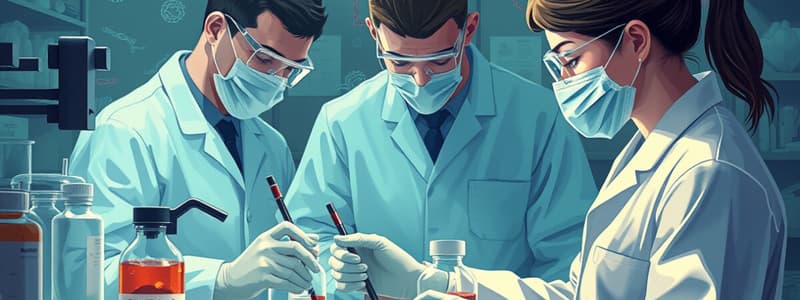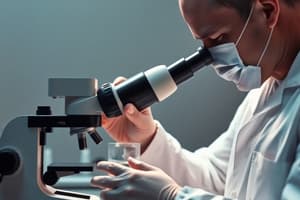Podcast
Questions and Answers
What is the primary focus of diagnostic microbiology?
What is the primary focus of diagnostic microbiology?
- To diagnose the etiologic agents of infections (correct)
- To characterize various laboratory techniques
- To ensure communication between healthcare providers
- To provide treatment for infections
Which aspect is essential for effective diagnostic microbiology?
Which aspect is essential for effective diagnostic microbiology?
- Proper communication between laboratory and clinician (correct)
- Standardized testing for all patients
- Advanced laboratory technology
- Routine specimen collection methods
Why is it important to specify the type of clinical specimen in diagnostic microbiology?
Why is it important to specify the type of clinical specimen in diagnostic microbiology?
- To reduce sample contamination rates
- To facilitate standardized laboratory procedures
- To validate the collection date and time
- To ensure proper identification and testing of pathogens (correct)
Which of the following factors influences the techniques used in diagnostic microbiology?
Which of the following factors influences the techniques used in diagnostic microbiology?
What details are crucial to include when collecting a clinical specimen?
What details are crucial to include when collecting a clinical specimen?
The role of the physician in the laboratory process emphasizes which of the following?
The role of the physician in the laboratory process emphasizes which of the following?
A diagnostic laboratory’s procedures can vary depending on what factor?
A diagnostic laboratory’s procedures can vary depending on what factor?
What may happen if there is a lack of communication between clinician and laboratory?
What may happen if there is a lack of communication between clinician and laboratory?
What information is necessary to include on a specimen label to improve the chances of isolating the pathogen?
What information is necessary to include on a specimen label to improve the chances of isolating the pathogen?
Which specimens should not be stored at room temperature?
Which specimens should not be stored at room temperature?
What is the recommended time frame for processing specimens to ensure better outcomes in pathogen isolation?
What is the recommended time frame for processing specimens to ensure better outcomes in pathogen isolation?
Which of the following conditions affects specimen storage temperature requirements?
Which of the following conditions affects specimen storage temperature requirements?
Which of the following details is least relevant to provide alongside a specimen collection?
Which of the following details is least relevant to provide alongside a specimen collection?
Why is it essential to collect specimens for microbiological testing within a specific timeframe?
Why is it essential to collect specimens for microbiological testing within a specific timeframe?
What is the significance of documenting recent travel on a specimen label?
What is the significance of documenting recent travel on a specimen label?
Which type of specimen can usually be stored at room temperature for microbiological testing?
Which type of specimen can usually be stored at room temperature for microbiological testing?
What aspect of a patient's health history is critical for microbiological diagnosis?
What aspect of a patient's health history is critical for microbiological diagnosis?
What action should be taken if a specimen cannot be plated within the recommended time frame?
What action should be taken if a specimen cannot be plated within the recommended time frame?
What is the main purpose of culturing microorganisms in a diagnostic microbiology context?
What is the main purpose of culturing microorganisms in a diagnostic microbiology context?
What type of sample is typically required for definitive identification at the onset of illness?
What type of sample is typically required for definitive identification at the onset of illness?
What limitation is associated with labeled and non-labeled reagent assays?
What limitation is associated with labeled and non-labeled reagent assays?
Which technique is used for the detection and quantification of specific DNA and RNA sequences?
Which technique is used for the detection and quantification of specific DNA and RNA sequences?
What is the role of specialized media in microbiological diagnostics?
What is the role of specialized media in microbiological diagnostics?
What is the primary function of diagnostic medical microbiology?
What is the primary function of diagnostic medical microbiology?
When should specimens be collected according to the guidelines?
When should specimens be collected according to the guidelines?
Which of the following is most crucial to ensure the effectiveness of laboratory analysis?
Which of the following is most crucial to ensure the effectiveness of laboratory analysis?
Specimens for microbial testing should be selected based on what key criteria?
Specimens for microbial testing should be selected based on what key criteria?
Which of the following steps is essential to confirm the presence of infectious agents?
Which of the following steps is essential to confirm the presence of infectious agents?
From which site should specimens ideally be collected?
From which site should specimens ideally be collected?
Why is timing important in the collection of specimens?
Why is timing important in the collection of specimens?
What is one of the purposes of testing specimens from patients?
What is one of the purposes of testing specimens from patients?
What type of responses does the collection of specimens help demonstrate?
What type of responses does the collection of specimens help demonstrate?
The use of antimicrobials should be guided by what practice?
The use of antimicrobials should be guided by what practice?
What is an acceptable specimen type for culture of Group A streptococci?
What is an acceptable specimen type for culture of Group A streptococci?
Which of the following statements about urine cultures is true?
Which of the following statements about urine cultures is true?
What concentration of NaOH is used for decontamination in diagnostic microbiology?
What concentration of NaOH is used for decontamination in diagnostic microbiology?
Which specimen type is NOT suitable for culturing known etiologic agents?
Which specimen type is NOT suitable for culturing known etiologic agents?
When sending multiple culture specimens, what is critical for proper laboratory protocol?
When sending multiple culture specimens, what is critical for proper laboratory protocol?
What is the primary purpose of using quantitative cultures in diagnostic microbiology?
What is the primary purpose of using quantitative cultures in diagnostic microbiology?
Which of the following is appropriate for preserving microbial viability during transportation?
Which of the following is appropriate for preserving microbial viability during transportation?
Which method is effective in decontaminating surfaces contaminated with microbial specimens?
Which method is effective in decontaminating surfaces contaminated with microbial specimens?
For which specimen is a deep cough induction preferred over sputum?
For which specimen is a deep cough induction preferred over sputum?
What is a key characteristic of routine throat specimens?
What is a key characteristic of routine throat specimens?
Flashcards
Diagnostic Microbiology
Diagnostic Microbiology
Focuses on identifying the cause of infectious diseases for accurate diagnosis.
Effective communication
Effective communication
The most critical requirement for specimen collection is a clear exchange of relevant details between the clinician and the lab to ensure accuracy and relevance of testing.
Key Patient Information
Key Patient Information
First/last name, sex, age, address, pregnancy, illness details (duration, onset, travel, signs/symptoms)
Two-Hour Collection Window
Two-Hour Collection Window
Signup and view all the flashcards
Special Handling Specimens
Special Handling Specimens
Signup and view all the flashcards
Microbiology Lab Functions
Microbiology Lab Functions
Signup and view all the flashcards
Optimal Collection Strategy
Optimal Collection Strategy
Signup and view all the flashcards
Culture techniques
Culture techniques
Signup and view all the flashcards
Genotypic Identification
Genotypic Identification
Signup and view all the flashcards
Study Notes
Diagnostic Microbiology Overview
- Focuses on identifying infectious agents' etiology for proper diagnosis.
- Essential for characterizing thousands of pathogens linked to infections.
- Techniques for identification differ among laboratories based on patient symptoms.
Guidelines for Clinical Specimen Collection
- Clear communication between clinician and lab crucial for accuracy.
- Key patient information required includes:
- First and last name
- Sex and age
- Address and pregnancy/lactation status (if applicable)
- Illness details: duration, onset, recent travel, signs/symptoms
- Specimen collection should occur within 2 hours of sample acquisition for optimal isolation chances.
Specimen Handling and Storage
- Specific storage conditions necessary; most specimens can be kept at room temperature, except:
- Urine, stool, viral specimens, sputum, swabs, gastric biopsies, and rectal swabs which require proper preservation.
Functions of a Microbiology Laboratory
- Conducts etiological diagnosis and isolation of infectious agents.
- Sets guidelines for prudent antimicrobial use.
- Tests specimens for microorganisms possibly responsible for illness.
- Provides information on antimicrobial drug effectiveness against identified pathogens.
Sample Collection Considerations
- Specimens collected from the active disease site for optimal yield.
- Timing critical; collect during acute illness phase before antibiotic administration.
- Specific collection for certain pathogens, e.g., deep cough or sputum for respiratory organisms instead of saliva.
Growth and Cultivation Methods
- Culture techniques vital for definitive pathogen identification; often the most sensitive approach.
- Can confirm infections by culturing agents in artificial media or living hosts.
Genotypic Identification
- Involves detecting and quantifying DNA/RNA sequences for viral and bacterial identification.
- Offers accurate detection but may have sensitivity limitations due to complex formation required for results.
Studying That Suits You
Use AI to generate personalized quizzes and flashcards to suit your learning preferences.




